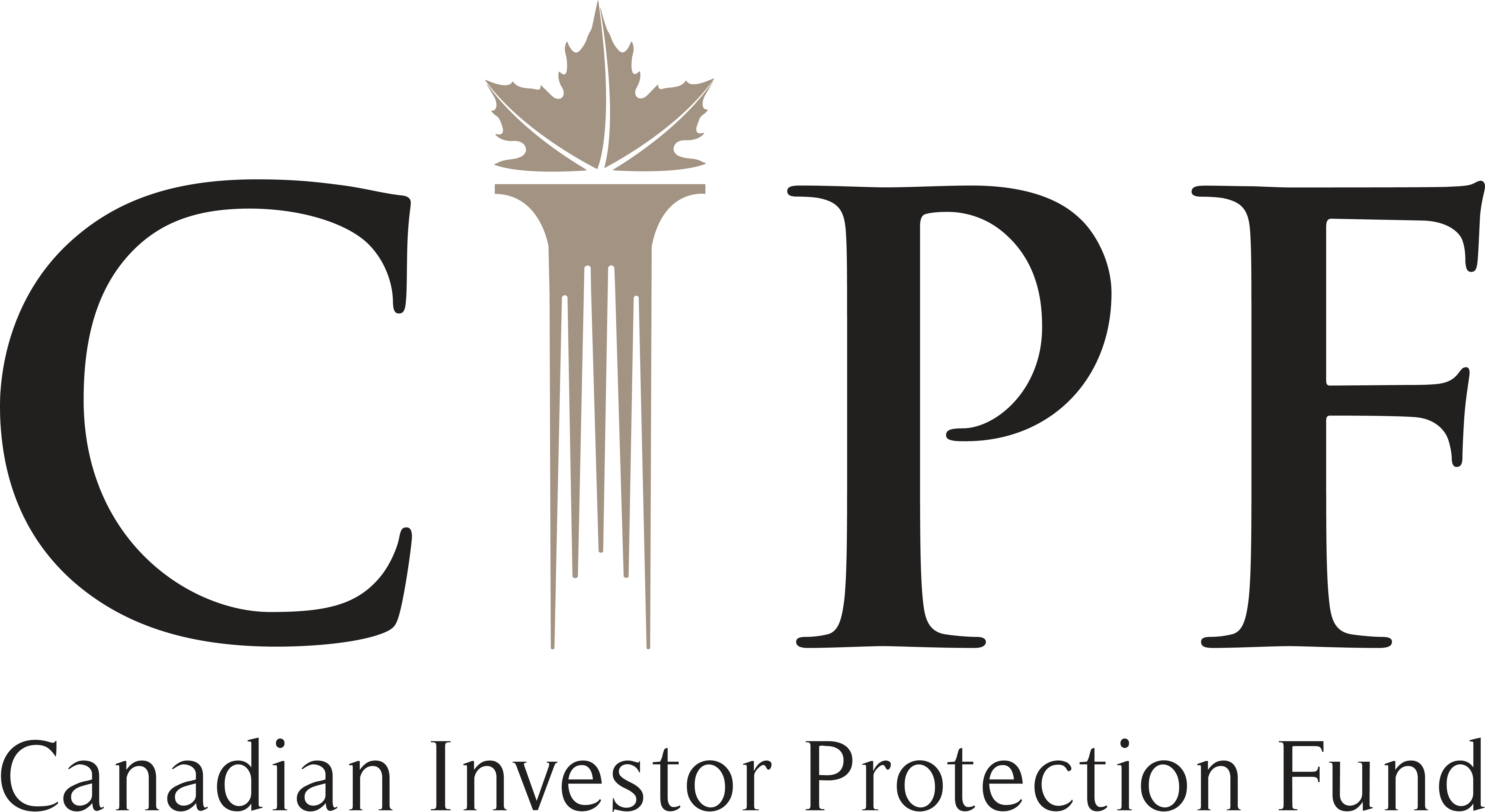Canadian Investor Protection Fund
Glossary
Glossary
Account
For the purposes of CIPF coverage, an account must be
- with a member firm,
- used solely for either holding or trading in securities or commodity and futures contracts, and
- fully disclosed in the records of the member firm. This is normally shown by receipts, contracts and statements issued by the member firm.
CIPF protection is also not available to customers for mutual fund dealer account located in Québec, unless the member firm is also registered as an investment dealer. A mutual fund dealer account is considered to be located in Québec for the purposes of CIPF coverage if the office serving the customer is located in Québec.
CIRO
Canadian Investment Regulatory Organization was formed by the amalgamation of the Investment Industry Regulatory Organization of Canada (the former national self-regulatory organization that regulated investment dealers in Canada) and the Mutual Fund Dealers Association of Canada (the former self-regulatory organization that regulated mutual fund dealers in Canada outside Québec) effective January 1, 2023.
Client (also called a Customer)
A client is an individual, corporation, partnership, trust, trustee, executor, administrator or other legal representative, unincorporated syndicate, or unincorporated organization. Note that CIPF will sometimes use the terms “client” and
“customer” interchangeably.
Client Name Assets
Property that is not held by the Member, or not recorded in a Customer's account as being held by a Member, such as mutual fund securities that are registered directly in the name of the Customer with the mutual fund company or deposits with financial institutions, is not eligible for CIPF coverage even though it was sold through the Member to the Customer. This kind of Property is commonly referred to as being in client name (as opposed to the nominee name of the Member) and is not eligible for coverage unless it is otherwise in the custody or control of the Member. Such custody or control may arise where a Member or its representatives have ostensible control over assets of a customer holding client name Property by virtue of a power of attorney, trading authorization or temporary receipt of cash intended to be received by a mutual fund company or other issuer.
Customer pool
This term is used in the context of an insolvency administered under Part XII of the Bankruptcy and Insolvency Act (Canada). If this law applies to the insolvency of a member firm, the trustee in bankruptcy establishes the customer pool fund under section 261(2) of the Bankruptcy and Insolvency Act (Canada). The customer pool fund includes:
- All securities and cash held by or for the account of every client of the member firm (other than customer name securities), and
- All securities and cash held by or for the account of the member firm.
For complete information on this term, please refer to sections 261(2) and 262 of the Bankruptcy and Insolvency Act (Canada).
ETF or Exchange-Traded Fund
An ETF refers to an exchange-traded fund. An ETF is a type of investment fund whose securities can be bought and sold on a stock exchange. In Canada, ETFs are generally structured as trusts or corporations, which are separate legal entities from the management company that administers them. Investing in an ETF gives an investor units or shares of the fund.
ETFs can be classified into two broad categories: physical and synthetic. Physical ETFs hold individual securities or physical assets such as commodities. Synthetic ETFs use derivatives to replicate the exposure of physical ETFs.
Insolvent / Insolvency
For purposes of CIPF coverage, a member firm is generally considered insolvent on the date that a court appoints a trustee in bankruptcy, receiver, liquidator or similar type of insolvency official for the member firm. If such an official is not appointed, CIPF generally considers a member firm to be insolvent on the date clients no longer have unrestricted access to their accounts if, for example, the member firm is suspended by CIRO.
Investment Fund
An investment fund (as such term is used in the context of this website) is a professionally managed investment vehicle that pools money of individuals and corporations and invests it in products such as shares, bonds, and foreign exchange, in an effort to achieve a specific objective over time. Two examples of investment funds are mutual funds and exchange-traded funds (ETFs).
Issuer
The company or other legal entity that issues securities is often called the “issuer” of securities. For example, in exchange for funds invested in Company X, investors may receive securities issued by Company X. In this example, Company X is the issuer.
Loss Calculation
This relates to the calculation of compensation for missing property, which is property held by a member firm on a client’s behalf that is not returned to the client following the member firm’s insolvency.
CIPF will provide compensation for the value of missing property as at the date of the member firm’s insolvency, subject to limits prescribed in the CIPF Coverage Policy. The date of insolvency of the member firm, for purposes of the calculation, will be determined by CIPF further to the terms of the CIPF Coverage Policy.
The maximum amount of compensation that CIPF will pay to a client is calculated after taking into account:
- the delivery to the client of property to which the client is entitled, and
- the distribution to the client of any assets of the insolvent member firm, less
- any amounts owing by the client to the member firm.
CIPF may also reduce a client’s claim for compensation if the client is entitled to receive, or has received, compensation from any other source.
Sample Calculation of Loss
100 shares of Company X are held by a member firm for client prior to insolvency
100 shares of Company X are not returned to client due to insolvency of member firm
Client’s purchase price of the shares was $50 per share
Value of the shares on the date of the member firm’s insolvency was $30 per share
Amount client owes to member firm is $1000Loss for CIPF Coverage Purposes = 100 shares x $30/each less $1000= $2000
Note that not all losses that may arise are covered by CIPF. For example, CIPF does not cover losses resulting from any of the following:
- a drop in the value of your investments for any reason
- investments that were not suitable for you
- fraudulent or other misrepresentations that were made to you
- misleading information that was given to you
- important information that was not disclosed to you
- poor investment advice
- the insolvency or default of the company or organization that issued your security
Member Firm
CIPF member firms are members of Canadian Investment Regulatory Organization (CIRO) that are: (i) investment dealers and/or (ii) mutual fund dealers. Please click here for a list of CIPF Investment Dealer member firms and here for a list of CIPF Mutual Fund Dealer member firms.
Mutual Fund
A mutual fund is a type of investment fund. In Canada, mutual funds are generally structured as trusts or corporations, which are separate legal entities from the management company that administers them. Investing in a mutual fund gives an investor units or shares of the fund.
Portfolio manager
A portfolio manager is a firm authorized to provide advice to a client with respect to investing in, buying or selling any type of security. If a client allows it, the portfolio manager can also make investment decisions without the client’s permission (called “discretionary authority”). In most cases, a portfolio manager is not a CIPF member.
Advising representatives are individuals (like a financial advisor) acting on behalf of a portfolio manager, who provide advice to clients with respect to investing in, buying or selling securities.
Portfolio managers and the advising representatives they engage must register with their provincial or territorial securities regulator. You can check the registration category or categories of a firm or individual through the Canadian Securities Administrators’ National Registration Search database.
Property
Property refers to securities, cash balances, commodities, futures contracts, segregated insurance funds or other property, received, acquired, or held by, or in the control of, the member firm for the client, including property unlawfully converted.
If securities are held directly by a client, meaning that the client has received the share certificate or other ownership documentation for the investment that he or she owns, CIPF coverage does not apply since the member firm is not holding
this property for the client.
CIPF coverage also does not apply to mutual funds registered in the client’s name and held directly at the mutual fund company.
Crypto assets are also not eligible for CIPF protection.
Securities
A “security” is a type of financial instrument. Examples of securities include: bonds, GICs (guaranteed investment certificates), shares or stock of a company, units or shares of an investment fund such as mutual fund or an ETF (exchange-traded fund), and units of limited partnerships.
A share or stock is an ownership interest in a company issued by that company. Securities issued by trusts or partnerships are often referred to as
“units”. The company or other legal entity that issues the securities is also often called the “issuer” of securities.
Shortfall
The term shortfall is used in the context of insolvencies administered under Part XII of the Bankruptcy and Insolvency Act (Canada). It refers to the difference, as determined by the trustee in bankruptcy, between property available to be returned to clients and property that the member firm owes to its clients at the date of bankruptcy of the member firm.
This glossary provides simplified explanations of terms used on this website. The CIPF Coverage Policy will govern exclusively in determining any claims.

